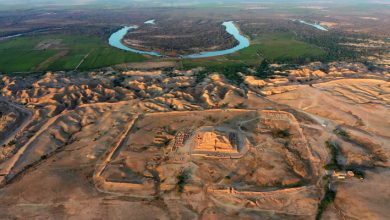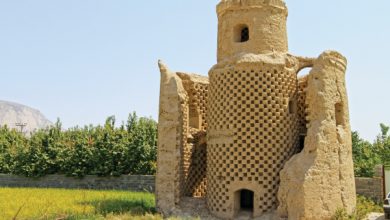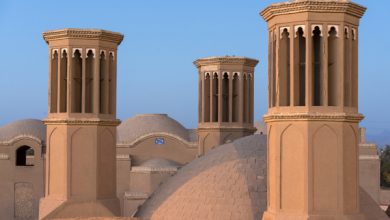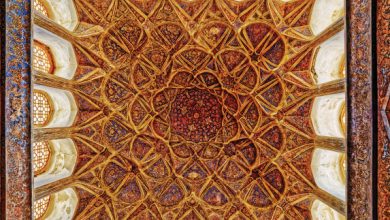
Bakhtiaris are the other large and famous tribal confederacies in Iran. They speak a type of Lori dialect and live in towns, villages and nomadic territories of the central parts of the lofty Zagros mountain range; Chahar Mahal-o-Bakhtiari, Khuzestan, Lorestan and Isfahan province. A small percentage of the Bakhtiaris are still nomadic pastoralists. The Bakhtiari nomads are divided into two major tribes; Chaharlang and Haftlang. They follow the typical nomadic lifestyle and move between summer quarters (yeylaq) in the high mountains and winter quarters (qeshlaq) in the western foothills adjoining the Khuzestan plain. The migratory routes which are followed annually and are seldom, if ever, changed because in this region there are five or at best seven cols over which the Zagros range can be crossed. They tend to stay at the same campsites as before. They migrate like other tribes with their herds and households. They raise sheep and goats which is their main source of income.
Through centuries, they have shown how well the community has adopted its lifestyle to the peculiar environmental condition of the Zagros; they gather wild plants and vegetables such as berries and mushrooms for cooking and others for dyestuffs and craft materials in addition to hunting. They mostly consume dairy products and in rare occasions meat. The nomadic life is not only a lifestyle but also an effort to survive which is impossible without all the family members’ contribution. No matter how old a member is, there are always vital responsibilities for each member of the tribe. Along with other family members, elderly women (dalu) have a fundamental role as well. Dalu hands down the traditions; teaches weaving secrets to the youngsters, leads singing in ceremonies, has an important role in marriage decisions and every daily activity of other women is done by her consultation.
It should be mentioned that the Bakhtiaris are passionately interested in hunting. Each family owns a rifle and fathers teach shooting and horse riding as the first and most important skills to their children. It goes without saying that the Bakhtiaris are well known for being great and brave riders and shooters. They are also known for their rich folklore. Their tales glorify the history of each tribal group and describe the adventures of their heroes.
Costumes
Inspired by nature, Bakhtiari women’s clothes have magnificent colors. Young women are fond of bright colors while elderly women tend to wear darker clothing. Their clothes include a cap (Lachak) which is usually decorated with coins, pearls, and glass beads; it is pinned to a veil (Meyna) in a way that frames the face without hiding it. Lachak is usually fixed by a silver chain (Sizan ban), decorated with coins and beads. They wear a pair of trousers under a long full skirt. The fabric of the skirt is gathered at the waist. Over the skirt, a knee length tunic is worn which has slits at the sides in order to accommodate the full skirt. In wedding ceremonies, women tend to wear armlets.
Bakhtiari tribe’s men wear a felt hat which is a small cap of beige or black and mostly worn by boys and shepherds; also a black or sometimes white tall skull-cap (Khosrowi) worn by mature men and chiefs (Khan). A masculine coat/vest in natural white wool with vertical indigo stripes which today is mostly worn over a jacket is (Chugha). Their trousers are black and cut very wide usually worn over under-pants held up by a rolled white cloth (Shal) if worn with a Chuqa and or by a leather belt if worn with a jacket. Men usually carry pipes, knives and other stuff in their Shals. Usually, both men and women wear cotton shoes (Giveh).
Crafts
Like other pasturing tribes of Iran, the Bakhtiari’s principal handicraft is weaving. The Bakhtiari carpet along with other weavings is a major art form of theirs which is among the most intriguing and distinctive styles of a Persian carpet. They have innovative and distinctive stylization, especially in their oversize carpets with rich colors and high-quality wool. A well-known pattern is called Kheshti (garden motifs) where the carpet is divided into squares with plants and animals, symbolizing the Persian garden. The best Bakhtiari carpet with the highest knot density is called Bibibaft.
Wedding Ceremonies
A preferred marriage model among the Bakhtiari is choosing spouse among relatives, as it is easier to reach an agreement. Some families, however, marry members of other sub tribes and thus, establish more extensive ties. When the male’s family assures that the girl they have chosen is not engaged, they ask an elderly woman to negotiate with the girl’s father. After a primary agreement, the boy’s father, paternal uncles, and cousins, will initiate the engagement. They go to the girl’s tent where her father, paternal uncles, and cousins are waiting for their guests. A boy is never welcomed without his relatives. The boy’s relatives ask the girl’s father for her daughter’s hand and after his agreement, they sometimes discuss the amount of money (Shirbaha) which should be paid by the groom to the bride’s family. Female members of the groom’s family take an engagement ring and a traditional women’s garment and a sack of henna to the bride’s family. Women sing happy local songs together. Consulting the horoscopes, they then choose the date for engagement and other ceremonies. The bride starts weaving a carpet as soon as the engagement is announced and finishes it before the wedding day as a dowry piece to show her weaving skills.
On the wedding day, the bride accompanied by a few of her relatives while riding on a horse goes to the groom’s tent. As the caravan bringing the bride arrives, the mother-in-law welcomes her by showering her with small coins and candies. During the daytime, men indulge in their favorite activities: horse riding, target shooting and the stick game (choob bazi). An amazing part of the celebration is a riding match between the young men of the two families. The groom’s family members ride their horses and accompany him to a big field, and then they meet the bride on her white horse accompanied by young men of her family, also riding horses. The Groom tries to steal the bride’s veil and run while the bride’s family tries to stop him and chase him away; their game might go on for several hours. Besides the riding events, shooting contests of all kinds take place. For dinner and lunch, guests are served with typical Bakhtiari dishes such as tahchin (rice with whole pieces of lamb buried underneath it), kebab (meat grilled on skewers consisting of either lambs, hunted gazelles or partridges), abrizi murq (chicken in spicy sauce) and for drinks, water or doogh (savory yogurt-base drink).
Music and dance are inseparable parts of the wedding; typical Bakhtiari music consists of saz (Bakhtiari flute with eight holes on top and two below) and the duhul (rudimentary drum made of sheep’s and goat’s skin, on which the drummer would hit with a curved goat’s horn). Bakhtiari minstrels (Toshmal) only have these two instruments which while playing them; beautiful local songs (Di Balal) reach your ears sung by tribeswomen. In typical Bakhtiari dance, the young men hold each other’s belt in a large circle with the girls in colorful Bakhtiari dress rotating in a smaller circle within. The girls hold colorful kerchiefs in each hand. The two groups only pass by each other in their regular rotation without touching. There are some different types of dances according to the dual’s beat. These folkloric dances have been repeated for centuries; nothing can change their unsophisticated but traditional steps and movements.At the end of the first day of the wedding ceremony, while the bride is going to the groom’s tent, she carries a baby boy in her arms to ensure her first child will be a boy. The wedding ceremony often takes several days to complete.
The rest of this article is published in the 1st volume of Gilgamesh international edition



